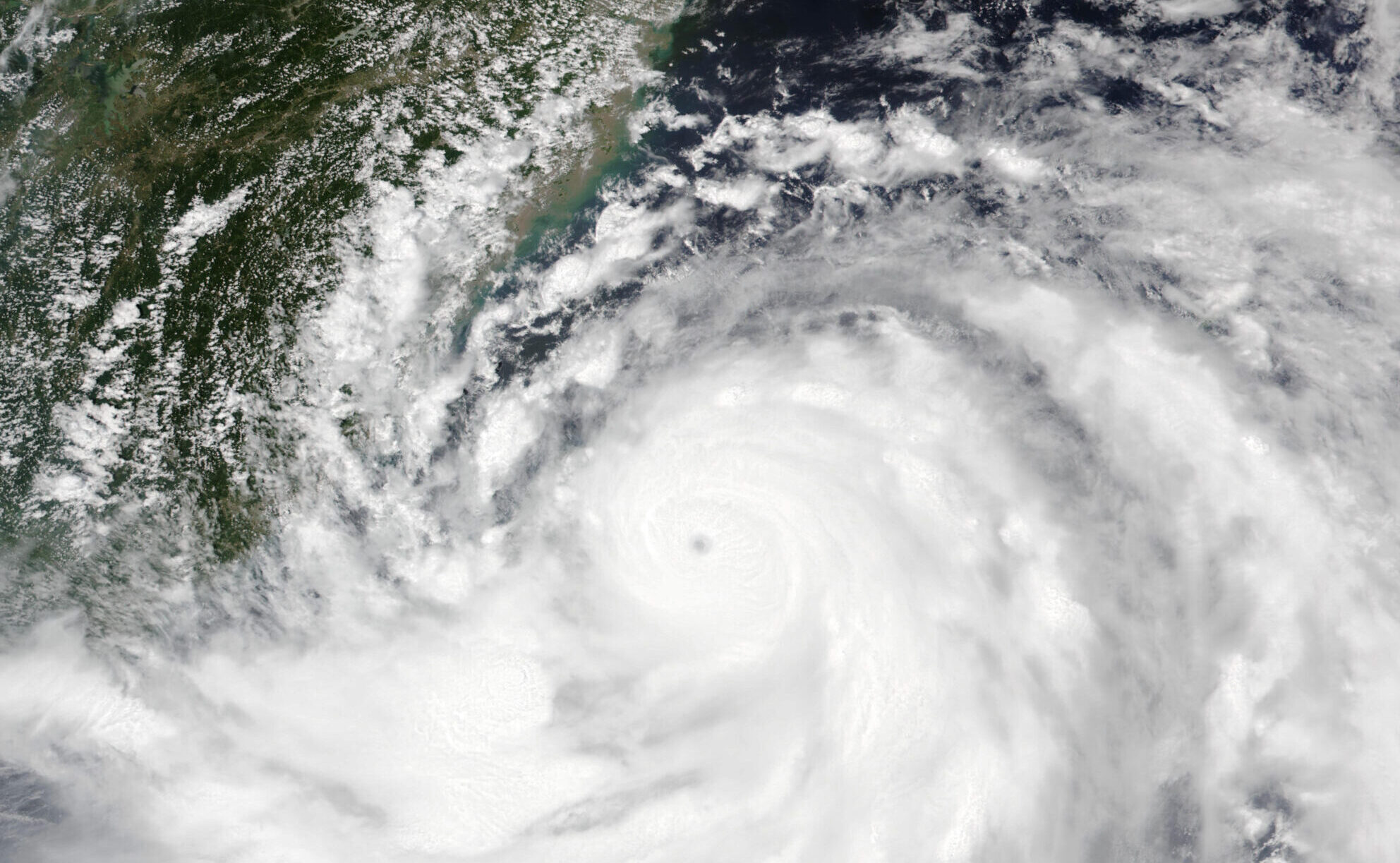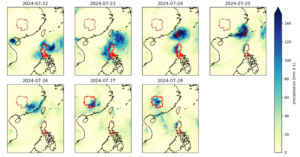
Typhoon Gaemi (known in the Philippines as Super Typhoon Carina) strengthened into a tropical storm on July 20th while tracking northwest towards the Philippines.
Typhoon Gaemi (known in the Philippines as Super Typhoon Carina) strengthened into a tropical storm on July 20th while tracking northwest towards the Philippines. Gaemi did not make landfall in the Philippines but interacted with the ongoing southwest monsoon (known locally as Habagat), causing heavy winds and torrential rainfall from July 22-24 in the northern Philippines. In total, 48 people were killed, with around 6.5 million affected by the severe conditions. 45 landslides were triggered across the northern islands, there were power outages in over 100 cities and municipalities, and around 400 sections of road and 30 bridges were damaged.
The storm intensified as it continued northwards towards the island of Taiwan, becoming a category 4-equivalent Typhoon on the 24th, with maximum (10-minute) sustained winds of 185 km/h. It made a prolonged landfall in northeast Taiwan on the 24th, bringing both heavy rain and high winds that killed 10 people and injured more than 900, while the agricultural sector reported damages of roughly US$50 million (FocusTaiwan, 2024a, FocusTaiwan, 2024b). It subsequently made landfall as a weaker, but still destructive tropical storm on mainland China on July 25. Gaemi brought heavy rainfall to coastal and inland regions, particularly the Hunan province, as it weakened to a tropical depression. Cyclone-based rainfall is uncommon so far inland in China and the heavy precipitation led to flooding and a mudslide that killed 15 people, and another 15 people in neighbouring provinces.35 remained missing a week after the disaster, and 290,000 people were evacuated (CNN, 2024).
The influence of climate change on tropical cyclones is complex compared to other types of extreme weather events. However, attribution studies are increasingly focusing on these destructive events. Rapid attribution studies to date have focused primarily on severe rainfall from such storms. Here, we use several different approaches to investigate the influence of climate change on multiple aspects of Typhoon Gaemi. The study focuses on the three geographic regions that experienced severe impacts – northern Philippines, the island of Taiwan and Hunan province, and analyse whether and to what extent human-induced climate change affected wind speeds and rainfall. To study the conditions that formed and fuelled Gaemi, we also analyse the role of climate change in high sea surface temperatures and potential intensity, a metric combining sea surface temperature, air temperature and air humidity data to predict maximum typhoon wind speeds. The study combines the established World Weather Attribution protocol with a new approach using the Imperial College Storm Model (IRIS) to analyse the role of human-induced climate change in tropical cyclones.

Main findings
- Typhoon Gaemi brought destructive winds and rainfall to large regions of southeast Asia, including the northern Philippines, Taiwan, and Hunan . At least 90 people were killed, thousands were injured and hundreds of thousands had to leave their homes. The extreme rainfall and high winds triggered landslides, widespread power outages and severe damage to infrastructure and agriculture.
- In today’s climate, that has already been warmed by 1.2C due to the burning of fossil fuels, weather observations indicate that rainfall events as severe as those brought by Typhoon Gaemi now occur about once every 20 (5 – 30) years in the northern Philippines, about once every 5 (1.5 – 20) years in Taiwan, and about once every 100 (90 – 160) years in Hunan province.
- To determine the role of climate change we combine observations with climate models. In Taiwan and Hunan, the rainfall was about 14% and 9% heavier respectively due to climate change, and in both regions, the rainfall total was made about 60% more likely by climate change. If the world continues to burn fossil fuels, causing global warming to reach 2°C above pre industrial levels, devastating Typhoon rainfall events in both regions will become 30-50% more likely.
- In the northern Philippines, the analysis did not identify a significant trend up to today. Observations indicate that 3-day rainfall events have increased by about 12%, however, there is large uncertainty in these data sets. Climate models suggest both increases and decreases in rainfall in the current climate, but an increase in a future climate with 2°C of warming.
- The IRIS model was used to investigate Gaemi’s strong winds by analysing category 4-equivalent storms in the Western North Pacific basin, a region that includes the South China and Philippine seas.
- By statistically modelling storms in a 1.2°C cooler climate, this model showed that climate change was responsible for an increase of about 30% in the number of such storms (now 6-7 times per year, up from 5 times), and equivalently that the maximum wind speeds of similar storms are now 3.9 m/s (around 7%) more intense.
- The conditions that formed and fueled Typhoon Gaemi were studied for links to climate change, using potential intensity and sea surface temperatures surrounding the storm track in July 2024. These conditions occur about every second year for potential intensity and about once every 15 years for sea surface temperatures.
- The influence of climate change on potential intensity is highly uncertain, as observations show a very large increase with warming (about a factor of 100 and a potential intensity increase of 6 m/s) that climate models do not capture. Sea surface temperatures as hot as those observed in July 2024 were almost impossible without climate change and have become about 1 degree warmer. If global warming reaches 2°C, sea surface temperatures are projected to be another 0.6°C warmer, and the conditions associated with Typhoon Gaemi will continue to increase in likelihood by a further factor of about 10.
- Together, these findings indicate that climate change is enhancing conditions conducive to Typhoons, and when they occur the resulting rainfall totals and wind speeds are more intense. This is in line with other scientific findings that tropical cyclones are becoming more intense and wetter under climate change.
- Rural communities with climate sensitive livelihoods (e.g. agriculture), the urban poor residing in the lowest lying land, and those living on exposed hillsides susceptible to landslides were the most affected by the multitude of hazards stemming from the typhoon.
- The regions affected by Typhoon Gaemi have early warning systems and comprehensive emergency response systems in place for tropical cyclones that help manage impacts. Flood risk associated with extreme rainfall is well-assessed in the affected regions, but existing urban plans and flood control infrastructure are not able to withstand the more extreme floods that are driven by climate change. Unplanned urban development, including in Metro Manila where the population has rapidly increased, is increasing the number of people at risk, especially in lower lying informal areas.





